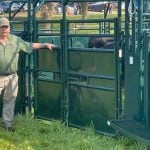WINNIPEG – Bill Richardt notices his aluminum trailer when he’s on the road.
“This aluminum trailer pulls quite a bit lighter than our steel trailer,” says the Clavet, Sask., farmer.
“We actually feel the difference on the road.”
Richardt, who hauls feeders and culls to market with a Dodge one-ton deck truck, also notices it in his pocketbook.
He said the aluminum trailer has the same dimensions as a steel trailer, but is probably 1,200 pounds lighter.
“We haul animals ranging from 600 up to 1,200 lb., so this means I can load one or two more animals per trip,” he said.
Read Also

VIDEO: Green Lightning and Nytro Ag win sustainability innovation award
Nytro Ag Corp and Green Lightning recieved an innovation award at Ag in Motion 2025 for the Green Lightning Nitrogen Machine, which converts atmospheric nitrogen into a plant-usable form.
“Over the long term, that’s a big economic benefit for us. We’re also seeing better fuel economy on the truck compared to pulling the steel trailer.”
Kim Henderson, who farms at Gainsborough, Sask., and bought his aluminum trailer this winter, agreed.
“It’s nice to pull compared to our steel trailer. You don’t even know it’s behind you. Even when we’ve got a full load, you feel the difference.”
Glen Joorisity of Warner Trailer Industries in Regina said bigger payload and easier pulling are only two of the reasons livestock producers are switching to aluminum trailers. He said that over time, longevity and resale value may be more important.
“One of our customers bought a Featherlite aluminum livestock trailer back in 1996,” Joorisity said.
“In June of 2002, he sold it for $15,000. A brand new Featherlite aluminum trailer of that same size and with the same features sells for $18,750 today. There aren’t many farm implements that you can buy and use for six years and then get nearly all your money back.
“The obvious economic benefit here is that if you maintain an aluminum trailer and do the regular pressure washing and acidizing every two years or so, it still looks brand new after 10 or 15 years. There’s no corrosion to down-value the trailer to scrap metal prices.”
Although there are no statistics to show how many aluminum and steel trailers are in use, Joorisity thinks aluminum has likely moved up to 35 or 40 percent of the total.
“The reason is that after a steel trailer corrodes to the extent that it’s not safe, it goes for scrap metal,” he said.
“It’s too far gone to fix it. We see this happening to steel trailers, sometimes in only 10 years. They’re off the books and out of circulation. They’re spent.”
Henderson knows what Joorisity is talking about.
“Our steel trailer is only 10 years old now and the body and sides are all rusted. They’re eaten out pretty good. It’s sure not scrap metal yet, but it’s bad enough that it needs to be fixed.”
Richardt had better luck with his steel trailer. He used it regularly for 23 years, which he says is almost unbelievable for a steel trailer.
“This one was originally built to haul rodeo stock, so everything is extra heavy steel throughout. And the other thing is that we’re pretty persnickety about our equipment, so that trailer got washed a lot. But now the axles are rusted, and they need to be replaced, so this seemed like the right time to move to aluminum.”
Joorisity said aluminum can also corrode from road salt on the underside and animal manure on the inside, but the difference is that when aluminum is cleaned, the corrosion stops.
Cleaning is critical in an aluminum trailer, he stressed. If a producer buys an aluminum trailer and then neglects it, he loses the benefit of longevity.
“Every two years or so, you should have the trailer acidized. That’s a solution of mild acid and soaps. It removes the tarnish and discolouration and corrosion and makes it look like brand new, like it’s just been polished.”
Combination aluminum-steel trailers are the worst for corrosion, he said.
“Where the two different metals meet, the corrosion of both the aluminum and the steel is accelerated. The only correct way to combine aluminum and steel is with a butyl tape to keep them from touching. This is a very thin film that insulates the two metals from each other.”
Joorisity said Featherlite trailers are made almost totally of aluminum, even the frame.
“The only steel is at the hitch and in the landing gear. Wherever there’s an interface between aluminum and steel, they have the butyl tape.”
While many producers like to have their trailers painted to match their farm or truck colours, Joorisity said that’s a problem with aluminum.
“Paint adhesion can be a real challenge with aluminum. But with the technology advances in coloured decal striping, you can have the trailer colour striped with any width or colour combination you desire. It’s like the city buses and highway buses. They have an aluminum skin with colored decal side stripes that seem to last forever.”
Joorisity said a new 24 by seven foot Featherlite has a dry weight of 4,150 lb. and sells for $23,300. In comparison, the shorter 20 foot by seven wide steel trailer has a dry weight of 4,675 lb. and sells for $19,000.
“Even if you don’t consider the longevity and the resale value, most guys figure they can make that extra $3,000 or $4,000 back in fuel savings and extra hauling capacity.”
While Henderson agrees the aluminum trailer brings fuel savings, he’s not so sure about the extra hauling capacity.
“I’ve only hauled three loads of cows and one horse so far, but I don’t think I can carry any extra critters in there.
“There’s only so much space in a 24 foot trailer, no matter what it’s built of. I think the size of a trailer will be more of the limiting factor than the weight.”

















